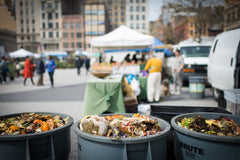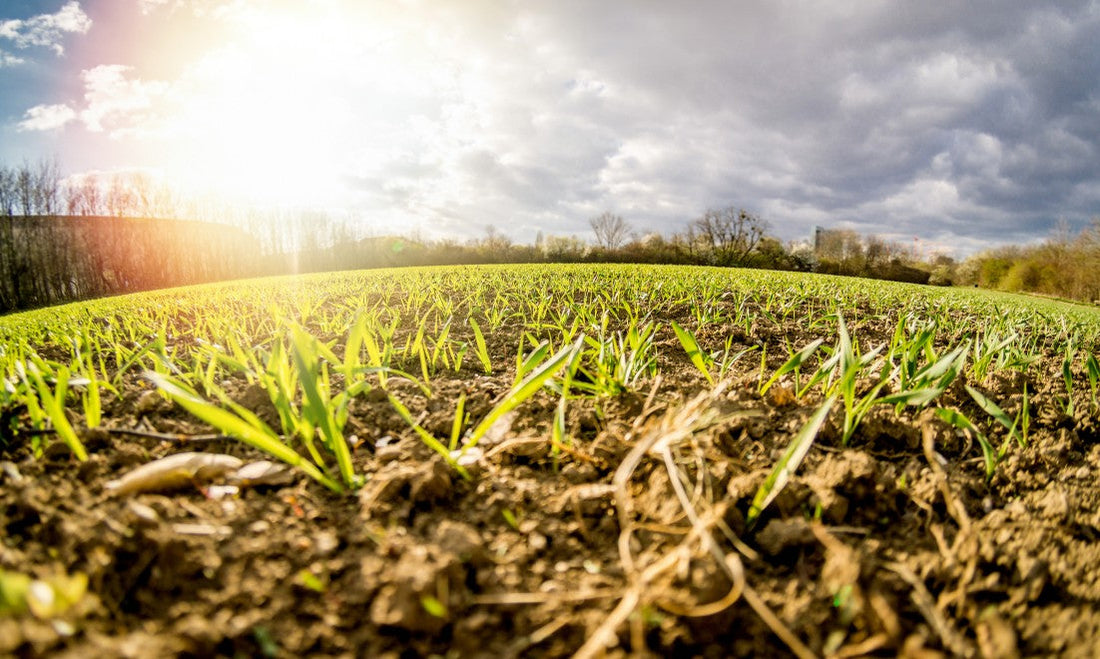Turfgrasses are like any plants, in that to reach their truest, greenest potential, you need to feed them. Using fertilizer is one way to feed grass, but there are many ways you can feed the grass and the microbes in your soil to achieve a quality lawn.
Fertilize to Feed Grass

Fertilizer is the most common way to feed grass. Fertilizer is added to soil to increase its fertility. Fertilizers add beneficial nutrients to your soil like a multivitamin adds nutrients to your diet.
Fertilizer 101
Six elements that are necessary for healthy plant growth:
- Oxygen
- Hydrogen
- Carbon
- Nitrogen
- Phosphorus
- Potassium
The first three elements, oxygen, hydrogen, and carbon, are all consumed by the plant above ground through the air and rain. Nitrogen, phosphorus, and potassium get absorbed through the soil. Even the most fertile soil will eventually be depleted of these vital nutrients as the plants eat and grow, which is why using fertilizer is essential to growing greener, healthier grass.
- Nitrogen (N) aids new leaf or vegetation growth.
- Phosphorus (P) helps with root development.
- Potassium (K) is responsible for helping the roots to regulate water, and move water and other nutrients from the roots to the plant cells.

All fertilizer labels include the percentage of these nutrients, or elements, with three numbers separated by dashes representing N, P, and K. The higher the number, the more of that particular nutrient. The rest of the fertilizer’s formula is fillers that work to distribute the nutrients evenly so the blades of the grass don’t get burned.
The breakdown of the fertilizer you use depends on your goal for your lawn. If you’re looking to feed grass to encourage better overall growth, use a balanced blend. Use a fertilizer higher in nitrogen for more lush, green growth during the active growing season. For winterizing your yard, feed grass with a fertilizer that is higher in phosphorus and potassium.
Always read the label on your fertilizer before you feed grass, do not over-fertilize, and do not fertilize new sod with high nitrogen products for at least a couple of weeks as it can stunt root development. Always feed grass in early spring, and in the fall, and as often as your particular species of grass will tolerate.
Different Kinds of Fertilizer
There are many different types of fertilizers you can use, and it’s perfectly acceptable to try different kinds and see which works best for you and your lawn.
- Slow-Release Fertilizers - Slow-release fertilizers gradually break down to supply plants with nutrients over a longer period. The gradual release of nutrients means that you can fertilize less often and still feed grass the nutrients it needs to thrive. Slow-Release fertilizer labels will indicate the percentage of slowly released nutrients, and the most beneficial macronutrient to look for in slow-release form is nitrogen.
- Inorganic Fertilizers - Inorganic means any material that comes from non-living materials. Inorganic fertilizers are human-made and include the macronutrients that are beneficial to plants. Inorganic fertilizers are available in both slow and quick-release formulas.
- Organic Fertilizers - Organic fertilizers come from plants or animals, like manure. Organic fertilizers are naturally more slowly absorbed, so many people combine the use of quick-release inorganic fertilizers with organic fertilizers that are then gradually absorbed.
- Granular Fertilizers - Dry or granular fertilizers are typically scattered across the yard and applied before watering or rainfall. The dry granules break down and feed the soil.
- Water Soluble Fertilizers - These fertilizers come in liquid form or crystals mixed with water. These types of fertilizers are easy to apply, deliver nutrients to the soil quickly, and have less sodium content, which is better for the grass.
Liquid Fertilizer Benefits
 Lawn care experts recommend liquid fertilizer for many reasons. Liquid fertilizers have a more homogenous mixture, meaning that every drop feeds grass with the same nutrient contents.
Lawn care experts recommend liquid fertilizer for many reasons. Liquid fertilizers have a more homogenous mixture, meaning that every drop feeds grass with the same nutrient contents.
Using liquid fertilizer to feed grass on a schedule every couple of weeks keeps the lawn consistently growing, maintaining a pristine and neat aesthetic. Grass absorbs liquid fertilizer through the roots and leaves, so it can be watered in or left to dry on the leaf surface.
How to Apply Liquid Fertilizer
Liquid fertilizers are the easiest way to feed grass but always dress appropriately. Wear long pants, long sleeves, and boots to protect your skin. These products can stain, so be careful to spray these away from your home, fence, or sidewalk. Simple Lawn Solution products can be attached directly to your hose to spray onto your yard without mixing the product manually. You can also use a backpack sprayer to be sure the liquid fertilizer doesn’t get too diluted.
Start with the perimeter of your yard and work inward, or walk in parallel lines to make sure you spray the whole lawn evenly. Kids and pets can get back on the lawn as soon as the liquid fertilizer dries. Using liquid fertilizer to feed grass is as easy as that!
When to Feed Grass
Feed grass with liquid fertilizer at least twice annually, at the beginning and the end of the growing season. As you anticipate the weather getting warmer, and your soil starting to thaw, plan to aerate and de-thatch your lawn. After you’ve loosened your soil, feed grass for the first time.
As the hot weather draws to an end, feed grass with liquid fertilizer again, to protect it from the cold weather. These are good basic lawn care practices, but using liquid fertilizer twice a year is the bare minimum.
How Often to Fertilize
For optimal growth, you should feed grass with a liquid fertilizer every six weeks during the growing season. The growing season for grass depends on the grass species but is typically from April through October. More growth means that your grass will utilize more nutrients, so you might need to increase your use of liquid fertilizer to feed grass more or less, depending on how fast your grass is growing.
While it’s crucial to feed grass to keep your yard looking its best, be sure not to over-fertilize, as you’ll be doing more harm than good.
The Best Time of the Day to Apply Liquid Fertilizer
Apply liquid fertilizer late in the afternoon to evening, avoiding the hottest part of the day. Adding liquid fertilizer to grass in the midday sun can scorch the grass, causing browning - the exact opposite of what you’re trying to achieve. Don’t apply the fertilizer to wet grass either, even if it’s just from dew. Wait until the grass dries before feeding.
Other Important Times to Feed Grass
Aside from the start and end of your grass’s growing season, there are some additional occasions you will want to feed your grass, as well. Be sure to apply starter fertilizer before you plant new grass. By doing this, you ensure that your soil has all the nutrients the new growth needs readily available.
Signs You are Over Fertilizing Your Lawn
If you’ve gotten too liquid fertilizer-happy, your lawn might experience the following:
- Leaf burn from excessive nitrogen
- Visible residue left on the surface of the soil
- Brown leaf tips
- Black or limp roots
- No growth after applying liquid fertilizer
If you suspect over-fertilization but aren't sure, you can get a soil test periodically to monitor your soil levels.
Once you’ve over-fertilized, don’t feed grass again until you’ve nursed your lawn back to health.
Can I Use Compost to Feed Grass?

Most lawn and gardening experts rave about compost. There is a distinction between compost and fertilizer, and for best results, many people use fertilizer in conjunction with compost. The reason for combining the two is that while fertilizer feeds the grass, compost feeds the soil.
Compost is decomposing organic matter, full of millions of microbes that help to cycle through nutrients in the soil, making them available to feed grass. You can buy compost, or make your own with kitchen scraps and grass clippings.
How to Make Your Own Compost
Making your own compost is easy, cost-effective, and good for the planet. Purchase a composting bin, or if you have enough land, start your compost on bare ground.
Using bare ground encourages worms and other organisms to help aerate your compost.
- Lay twigs, branches, and straw as the first layer of your compost pile.
- Alternate laying wet and dry materials down. The wet materials are kitchen scraps, seaweed, tea bags, etc. Dry ingredients are sawdust, straw, leaves, etc.
- Add manure to activate your compost pile and start the decomposition process.
- Water your compost pile occasionally to keep it damp.
- Cover the pile to keep it moist and increase the heat. The moisture and the heat are what “cooks” the compost.
- Every few weeks you, need to “turn” the compost with a shovel or pitchfork to aerate. Oxygen is another crucial ingredient in composting.
The secret to healthy compost is to have a higher ratio of carbon-emitting material than nitrogen-emitting material.
Some common materials that emit carbon are:
- Wood chips
- Wood ash
- Straw
- Shrub leaves and branches
- Paper
- Sawdust
- Pine needles or leaves
- Newspaper
- Dryer lint
- Cardboard
Materials that emit nitrogen are:
- Tea leaves
- Kitchen scraps
- Seaweed
- Weeds from the garden and lawn
- Grass clippings
- Flower cuttings
- Coffee grounds
Things to avoid in your homemade compost are:
- Meat or bones
- Perennial weeds
- Diseased plants
- Pet waste
Feed Grass with Grass Clippings
Another popular tip with lawn experts is to let your grass clippings (from mowing your lawn) lie. Grass clippings decompose and become an additional method to feed grass. While not enough to replace liquid fertilizer, grass clippings can give your yard a boost of food between your regularly scheduled fertilizer applications.

A common misconception about leaving grass clippings to lie is that it leads to thatch build-up, but this is not the case, as long as you are correctly mowing your grass. By this, we mean as long as you’re not removing much more than ⅓ of the length of your grass, the clippings break down and are reabsorbed fairly quickly. If you let your grass get long and then hack it all off, that is not the time to let the clippings lie, as they will accumulate faster than they can break down, which does contribute to a build-up of thatch.
As mentioned before, grass clippings can be a part of your homemade compost material, if you decide to bag them up as you mow.
There are many ways to feed grass and maintain a beautiful green lawn effectively. Take your time to figure out what works for you and your grass, but a great place to start is a quality liquid fertilizer and allowing your grass clippings to lie.















